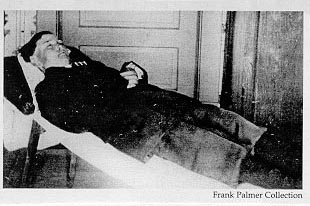|

Eleven-year-old William Snyder Jr., April 22, 1914.
Year after year coal miners died violently and frequently in
Colorado mines. Hazards in early Colorado mines doubled fatality rates
everywhere else in the world. The high death tolls reflected gross
negligence on the part of coal companies concerning mine safety.
Miners living conditions were primitive and they were forced to
live in fenced camps patrolled by armed guards. Workers were paid in
"scrip" which was good only at a company store.
When mine owners were criticized for their brutal treatment of
workers, they reminded their critics that the miners were only
"ignorant, lawless and savage South European peasants." Coal
camps were viewed as "little United Nations of the poor"
where "foreigners were seen as a threat because of the unrest in
Europe that led to World War I a few years later."
Union organization was slow. It was not easy for union
representatives to enter fenced mine camps patrolled by armed guards.
But by the end of 1911, "a complicated spy network operated in
the southern coal fields." Union organizers worked in the mines
to recruit members but company spies worked just as hard to locate
union organizers. Union miners were fired, tarred and feathered,
threatened, beaten, and/or rounded up and taken across state lines and
abandoned in remote areas without any supplies. Still the union
movement gained strength.
In 1913, miners drew up a list of demands and presented them to the
coal mine owners:
Recognition of the union.
A raise in wages.
An eight-hour day.
Pay for dead work (brushing, timbering, laying rail, etc.).
A weigh-man at all mines elected by the miners.
Right to trade in any store they chose.
Right to choose their own boarding places and doctors.
Enforcement of the Colorado mining laws.
Abolition of the guard system.
When the owners ignored the miners' demands, the United Mine
Workers of America called for a strike on September 23, 1913. After
they were evicted from their company housing, some 10,000 miners moved
to tent colonies established by the UMW on land rented by the union
east of the coal camps. As miners and their families moved into the
tent cities in locations near Aguilar, Forbes, Ludlow, Starkville and
Walsenburg, they were confident the mine owners would soon meet their
demands.
But the mine owners had no intention of even considering the
workers' demands. They hired more "Baldwin-Felts
detectives," doubled the guards around company property,
purchased large quantities of rifles and ammunition and demanded the
governor send in National Guard troops to protect mine property.
"Using troops to favor the position of coal companies was
illegal, but it was a practice that went on in Colorado for many
years."
The Rockefeller-owned Colorado Fuel & Iron steel mills in
Pueblo, Colorado even built a unique armored car for the company.
"With bulletproof sides and machine guns mounted in the back, it
was nicknamed the ‘Death Special' by miners because the gunmen who
used the car took perverse delight in spraying bullets through the
tents as they roared past the colonies. At the Ludlow camp, men dug
holes under the tents to protect their families from the flying
bullets that tore through their canvas homes."
"The winter of 1913-14 was one of the worst recorded in
Colorado history. Mountains of heavy snow piled up in the streets. The
canvas shelters were cold and often wet. Hunger stalked the families.
The men hunted daily, and if lucky, added a rabbit or deer to their
skimpy menus."
By spring the financial burden of keeping troops in the field was
bankrupting the state and as members of the regular National Guard
grew tired of the long tour of duty and asked to be replaced, more
coal company gunmen began appearing in uniform. On April 14, 1914, the
Colorado governor withdrew all but two outfits of troops from the
field. The two troops left, made up mostly of company men, mine guards
and gunmen, were stationed near Ludlow, 18 miles north of Trinidad.
On Easter night (April 19), company-employed gunmen and members of
the National Guard drenched the strikers' tents with oil and brooms
dipped in kerosene. Before dawn, they ignited the tents while the
miners and their families were asleep. When the miners, their wives
and their children ran from the burning tents, they were
machine-gunned. Many escaped in the darkness, many were wounded, but
five men, two women and 13 children died.
Eleven of the children and the two women, one pregnant, died in a
dugout under one tent where they had taken refuge but instead died of
suffocation. Eleven-year old William Snyder Jr. was killed instantly
by a bullet to the head when he left the protection of the dugout to
get water for his mother. The site was soon christened "The Black
Hole of Ludlow."
(When the UMW built the Ludlow monument in 1918, it was placed
directly east of the Black Hole. The pit itself was cemented in with
stairs going into the hole where the women and children perished
during the massacre. A trap door seals the pit from the elements, but
it can be opened and visitors may go down into the hole.)
Mine owners quickly issued statements charging the striking miners
with "starting the fight at Ludlow" and maintained an
overturned stove started the fire that killed the women and children.
They blamed "cheap professors, even cheaper muckraking magazines
and a lot of milk and water preachers" for making a mountain out
of a mole hill with the story of the massacre.
John D. Rockefeller, Jr., however, took full responsibility for the
massacre, saying it "was the unfortunate outcome of a principled
fight he was bound to make for the protection of the workingman
against trade unions."
(Sources: Labor's Untold Story, Richard O. Boyer & Herbert M.
Morais, and "Remember Ludlow," Joanna Sampson.)
|

